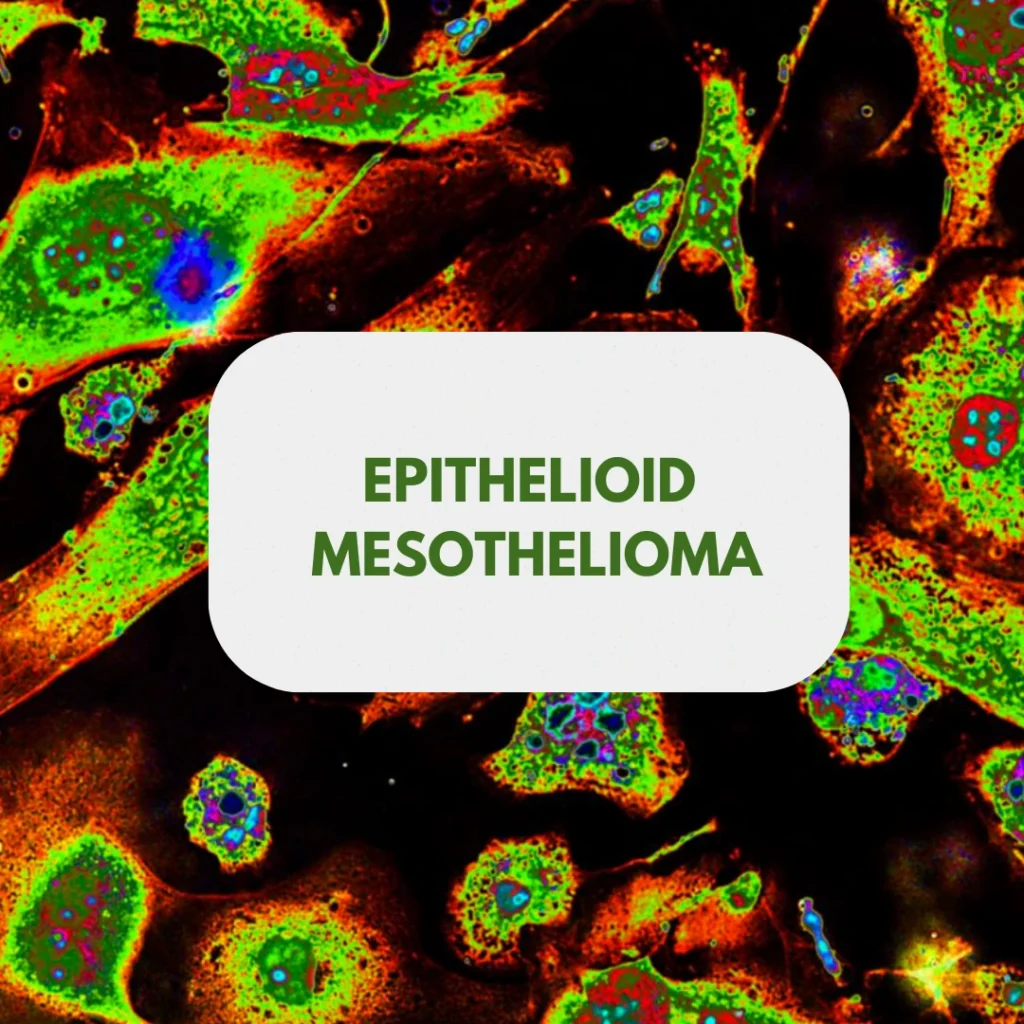Key takeaways: Epithelioid mesothelioma is the most common subtype of mesothelioma, with
about 50-70% of cases originating in epithelioid tissues. This subtype of mesothelioma has the
best prognosis, grows more slowly than other mesothelioma subtypes, and can usually be
diagnosed quicker. Importantly, new diagnostic criteria that extend beyond the distinction of
subtypes is helping doctors diagnose epithelioid mesothelioma much faster. By effect, this means
a quicker and more effective treatment plan.

What are Epithelioid Cells?
Epithelioid cells line the surfaces of organs; most commonly, these cells are associated with the
outermost layer of the skin, the epidermis. Epithelioid cells have a marked physiology: they have
large, visible nuclei, often arrange themselves in distinct shapes, and divide relatively faster than
other types of somatic cells. They are categorized based on their shape, which can be columnar,
cubed, or flat (squamous).
How is Epithelioid Mesothelioma Different From Other Forms of Mesothelioma?
This subtype of mesothelioma is the most common form of mesothelioma. By “form,” we mean how
and where the aggressive cancer originates. Like the other manifestations of mesothelioma,
epithelioid is known to be associated with asbestos exposure.
● About 50-70% of all mesothelioma cases originate in the epithelial pleural tissues around
the lungs.
● Epithelioid mesothelioma tumors–despite the epithelial tendency to quickly divide–grow
more slowly than other types of mesotheliomas.
● Epithelioid mesothelioma tumors have a distinct circular shape. The cancerous cells
group in characteristic clusters, which makes them somewhat easier to diagnose
compared to biphasic or sarcomatoid originations. (Biphasic and sarcomatoid refer to the
types of cells that mesothelioma can originate in, just like “epithelioid” refers to a class of
cells.)
● The prognosis for epithelioid mesothelioma is relatively better than the rarer originations;
this is because a.) it is easier to diagnose; b.) more is known about its growth and
progression; and c.) its characteristic clusters adhere to and impact healthy tissue more
slowly.
● Multimodal treatment, or using different therapies in conjunction with one another, is
usually the best course of action of epithelioid mesothelioma. Usually, these treatments
include surgery (if possible) and either chemotherapy or a clinical trial.
The Nuclear Grading Scale
Although we had covered the three distinctions of mesothelioma cell type, the World Health
Organization (WHO) recently revamped the diagnostic and phenotypic (how it physically looks
and is situated) requirements for mesotheliomas. The breaking down of mesotheliomas into three
subtypes is called nuclear grading. While this is important for distinguishing possible treatment
options and prognostic outcomes, it’s relatively fallible and inexact. Instead, doctors are opting
for immunohistological indicators of epithelioid mesothelioma. This means that they’re looking
for certain biomarkers and immune checkpoints that align with previous epithelioid
mesothelioma cases. For instance, a certain immune cell might be significantly upregulated, or
there could be certain mutations in the tumor’s cells that are characteristic of epithelioid
mesothelioma. There are also blood-based markers of epithelioid mesothelioma: calretinin is a
calcium-binding protein that is present in almost every case, and its presence can be tested for
within a few minutes.
New diagnostic criteria are helping doctors more quickly identify epithelioid mesothelioma and
the other subtypes of mesothelioma, too. This means that treatment plans can be administered
much more quickly than in the past. Because we’ve established that mesothelioma is an
aggressive cancer, the sooner the diagnosis, the better the prognosis. As diagnostic criteria
evolve, so will the prognosis for mesothelioma.
If you or a loved one has been diagnosed with an asbestos-related disease, please call
(800)-505-6000 for legal help. For more information, fill out the form on our Contact Us page.
Sources:
Blum, W., Pecze, L., Rodriguez, J. W., Steinauer, M., & Schwaller, B. (2018). Regulation of
calretinin in malignant mesothelioma is mediated by septin 7 binding to the CALB2
promoter. BMC Cancer, 18(1), 475. https://doi.org/10.1186/s12885-018-4385-7
Mastromarino, M. G., Lenzini, A., Aprile, V., Alì, G., Bacchin, D., Korasidis, S., Ambrogi,
M. C., & Lucchi, M. (2022). New Insights in Pleural Mesothelioma Classification
Update: Diagnostic Traps and Prognostic Implications. Diagnostics, 12(12), 2905.
https://doi.org/10.3390/diagnostics12122905
Paajanen, J., Laaksonen, S., Kettunen, E., Ilonen, I., Vehmas, T., Salo, J., Räsänen, J.,
Sutinen, E., Ollila, H., Mäyränpää, M. I., Myllärniemi, M., & Wolff, H. (2020).
Histopathological features of epithelioid malignant pleural mesotheliomas in patients
with extended survival. Human Pathology, 98, 110–119.
https://doi.org/10.1016/j.humpath.2020.02.007
Ph.D, K. M. (2020, May 17). Epithelial Cells—The Definitive Guide. Biology Dictionary.
https://biologydictionary.net/epithelial-cells/